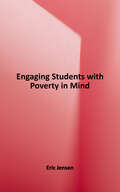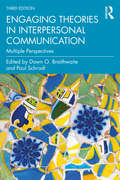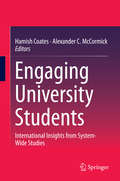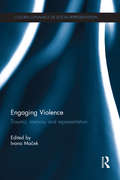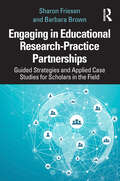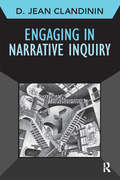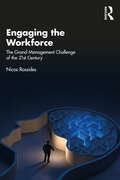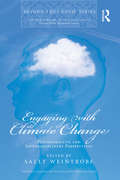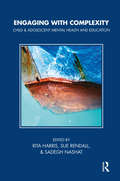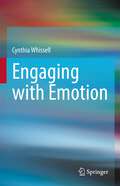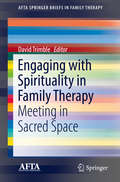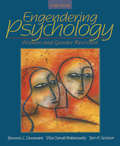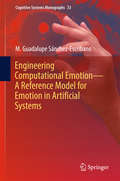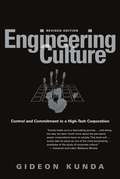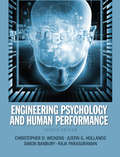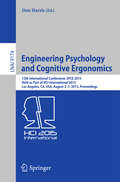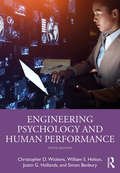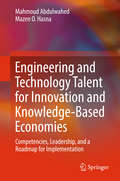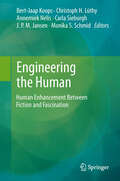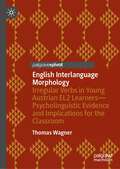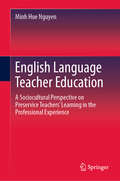- Table View
- List View
Engaging Students with Poverty in Mind: Practical Strategies for Raising Achievement
by Eric JensenIn this galvanizing follow-up to the best-selling Teaching with Poverty in Mind, renowned educator and learning expert Eric Jensen digs deeper into engagement as the key factor in the academic success of economically disadvantaged students. Drawing from research, experience, and real school success stories, Engaging Students with Poverty in Mind reveals: - Smart, purposeful engagement strategies that all teachers can use to expand students' cognitive capacity, increase motivation and effort, and build a deep, enduring understanding of content. - The (until now) unwritten rules for engagement that are essential for increasing student achievement. - How automating engagement in the classroom can help teachers use instructional time more effectively and empower students to take ownership of their learning. - Steps you can take to create an exciting yet realistic implementation plan. Too many of our most vulnerable students are tuning out and dropping out because of our failure to engage them. It's time to set the bar higher. Until we make school the best part of every student's day, we will struggle with attendance, achievement, and graduation rates. This timely resource will help you take immediate action to revitalize and enrich your practice so that all your students may thrive in school and beyond.
Engaging Theories in Interpersonal Communication: Multiple Perspectives
by Dawn O. Braithwaite Paul SchrodtThe third edition of this text maintains its place as a key resource for learning the foundational and emerging theories in the field of interpersonal communication. With each chapter devoted to a specific theory and authored by experts in that theory, the book gives students and scholars a comprehensive overview of this field. This edition features an expanded discussion of theory development and evaluation, a new section on theories of identity and difference in close relationships, and increased attention to social media.With the theory chapters sharing the same structure, the book ensures consistent coverage of topics within each theory. This book is an essential text for advanced undergraduate and graduate courses in interpersonal communication and is a valued resource for scholars.
Engaging University Students
by Hamish Coates Alexander C. MccormickThis book provides university teachers, leaders and policymakers with evidence on how researchers in several countries are monitoring and improving student engagement--the extent to which students are exposed to and participate in effective educational practices. It captures insights from international implementations of the National Survey of Student Engagement (NSSE), developed in the United States. In the last half decade NSSE has been adapted and used in several other countries, producing the largest international collaboration yet involving educationally relevant data on students' engagement in higher education. Leaders of established national collaborations draw on their experiences with hundreds of institutions to contribute their insights. Framed by their cultural and educational contexts, they discuss issues concerning first-year learners, international students, part-time and distance learners, as well as teaching and leadership in support of student learning. Each chapter outlines strategies based on national case studies and presents perspectives supported by concrete examples of how these have played out in diverse settings. The book suggests mechanisms that can be used by institutions, ministries and quality agencies around the world.
Engaging Violence: Trauma, memory and representation (Cultural Dynamics of Social Representation)
by Ivana MačekThis volume opens up new ground in the field of social representations research by focusing on contexts involving mass violence, rather than on relatively stable societies. Representations of violence are not only symbolic, but in the first place affective and bodily, especially when it comes to traumatic experiences. Exploring the responses of researchers, educators, students and practitioners to long-term engagement with this emotionally demanding material, the book considers how empathic knowledge can make working in this field more bearable and deepen our understanding of the Holocaust, genocide, war, and mass political violence. Bringing together international contributors from a range of disciplines including anthropology, clinical psychology, history, history of ideas, religious studies, social psychology, and sociology, the book explores how scholars, students, and professionals engaged with violence deal with the inevitable emotional stresses and vicarious trauma they experience. Each chapter draws on personal histories, and many suggest new theoretical and methodological concepts to investigate emotional reactions to this material. The insights gained through these reflections can function protectively, enabling those who work in this field to handle adverse situations more effectively, and can yield valuable knowledge about violence itself, allowing researchers, teachers, and professionals to better understand their materials and collocutors. Engaging Violence: Trauma, memory, and representation will be of key value to students, scholars, psychologists, humanitarian aid workers, UN personnel, policy makers, social workers, and others who are engaged, directly or indirectly, with mass political violence, war, or genocide.
Engaging in Educational Research-Practice Partnerships: Guided Strategies and Applied Case Studies for Scholars in the Field
by Sharon Friesen Barbara BrownEngaging in Educational Research-Practice Partnerships guides academic researchers into forming mutually respectful, collaborative, and scalable partnerships with school practitioners. Despite robust theoretical and conceptual planning, research on learning is often removed from real settings and generates findings with limited practical relevance, yielding frustration for K-12 stakeholders. This book provides invaluable resources to researchers seeking to work with practitioners as they solve problems and improve outcomes while answering fundamental questions about who gets to generate knowledge, from where, to whom, and in what contexts. A range of illustrative case studies and strategies explores how to apply appropriate theories and methodologies, negotiate agendas that ensure mutually beneficial goals, determine the role of pracademics, establish institutional supports, policies, and procedures that amplify impact and sustainability, and much more.
Engaging in Narrative Inquiry (Developing Qualitative Inquiry #9)
by D. Jean ClandininNarrative inquiry examines human lives through the lens of a narrative, honoring lived experience as a source of important knowledge and understanding. In this concise volume, D. Jean Clandinin, one of the pioneers in using narrative as research, updates her classic formulation on narrative inquiry (with F. Michael Connelly), clarifying, extending and refining the method based on an additional decade of work. A valuable feature is the inclusion of several exemplary cases with the author’s critique and analysis of the work. The rise of interest in narrative inquiry in recent years makes this is an essential guide for researchers and an excellent text for graduate courses in qualitative inquiry.
Engaging the Disengaged
by Tarquam McKenna Marcelle Cacciattolo Mark Vicars Tarquam Mckenna Marcelle CacciattoloEngaging the Disengaged addresses strategies and models of immersive teaching and learning that lead to successful schooling outcomes. The new Australian Curriculum emphasises the importance of improved educational participation. This book will equip pre-service teachers with the tools and strategies they need to successfully implement these priorities. Drawing together a diverse range of experts, this book offers innovative ways of thinking about student engagement. Addressing education across early primary, middle and secondary school levels, it explores how differences in culture, sexuality and wealth can alienate students, and examines challenges faced by schools in rural, remote and high-poverty settings. It also offers new ideas for engaging students in subjects such as mathematics, physical education and the arts. Contemporary, real-life case studies help connect theory to practice. Each chapter also includes learning objectives, further reading suggestions and a reflective closure, as well as a set of strategies for invigorating disadvantaged students.
Engaging the Workforce: The Grand Management Challenge of the 21st Century
by Nicos RossidesGrounded in 25 years of research and practical experience, this book shows how to create engaging work environments and practices that harness employees’ energy and talents toward achieving organizational goals, while enhancing workers’ motivation and well-being. Creating and sustaining high functioning work environments lies at the core of management practice, and employee engagement is a key element in shaping these workplaces – and a significant challenge for business leaders. Academic researchers and practitioners have tackled the topic, but a chasm exists between these perspectives: academics tend to emphasize theory over problem-solving, while practitioners tend to rely on formulaic approaches and experience, rather than empirically tested theoretical frameworks. Thought leader, accomplished CEO, and organizational development consultant Nicos Rossides bridges this gap, exploring the complexity and fragmented nature of the academic literature and offering insight into practitioner approaches used by research and consulting organizations. He also presents his own conceptual framework that he has built over the years and is meant to be customized to specific organizational contexts. This insightful book will be of great interest to CEOs, board members and line managers across industries, as well as HR/OD practitioners and students, especially those who wish to learn how to apply time-tested intervention strategies to the workplace engagement challenge.
Engaging the Workforce: The Grand Management Challenge of the 21st Century
by Nicos RossidesGrounded in 25 years of research and practical experience, this book shows how to create engaging work environments and practices that harness employees’ energy and talents toward achieving organizational goals, while enhancing workers’ motivation and well-being.Creating and sustaining high functioning work environments lies at the core of management practice, and employee engagement is a key element in shaping these workplaces – and a significant challenge for business leaders. Academic researchers and practitioners have tackled the topic, but a chasm exists between these perspectives: academics tend to emphasize theory over problem-solving, while practitioners tend to rely on formulaic approaches and experience, rather than empirically tested theoretical frameworks. Thought leader, accomplished CEO, and organizational development consultant Nicos Rossides bridges this gap, exploring the complexity and fragmented nature of the academic literature and offering insight into practitioner approaches used by research and consulting organizations. He also presents his own conceptual framework that he has built over the years and is meant to be customized to specific organizational contexts.This insightful book will be of great interest to CEOs, board members and line managers across industries, as well as HR/OD practitioners and students, especially those who wish to learn how to apply time-tested intervention strategies to the workforce engagement challenge.
Engaging with Climate Change: Psychoanalytic and Interdisciplinary Perspectives (The New Library of Psychoanalysis 'Beyond the Couch' Series)
by Sally WeintrobeHow can we help and support people to face climate change? Engaging with Climate Change is one of the first books to explore in depth what climate change actually means to people. It brings members of a wide range of different disciplines in the social sciences together in discussion and to introduce a psychoanalytic perspective. The important insights that result have real implications for policy, particularly with regard to how to relate to people when discussing the issue. Topics covered include: what lies beneath the current widespread denial of climate change how do we manage our feelings about climate change our great difficulty in acknowledging our true dependence on nature our conflicting identifications the effects of living within cultures that have perverse aspects the need to mourn before we can engage in a positive way with the new conditions we find ourselves in. Through understanding these issues and adopting policies that recognise their implications humanity can hope to develop a response to climate change of the nature and scale necessary. Aimed at the general reader as well as psychoanalysts, psychotherapists and climate scientists, this book will deepen our understanding of the human response to climate change.
Engaging with Complexity: Child and Adolescent Mental Health and Education (Tavistock Clinic Series)
by Rita Harris Sue Rendall Sadegh NashatChildren and young people spend a great deal of their time in schools and other education settings. Consequently those working in such contexts have a huge impact and influence on the development, experiences and thinking of the children and young people with whom they interact. This book represents the richness and variety of ideas shared by some of the contributors to the first European Conference on Child and Adolescent Mental Health in Education Settings, held in Paris in 2005 and hosted by the Tavistock and Portman NHS Foundation Trust. The intention of the event was to gather together child mental health and educational professionals from across Europe to share innovative practice. The success and impact of this conference was such that it became the first of what is now a bi-annual series of events each taking place in a different European city.
Engaging with Emotion
by Cynthia WhissellThis work informs by encouraging the reader to interact with the text itself and with the literature in the area. It is a learning tool rather than an encyclopaedic presentation of its topic. The writing style is personal, direct and accessible. Citations are employed, but always for specific purposes. Cited materials are made accessible whenever possible by the provision of URLs. Readers learn about emotion and its relationship to brain, body, cognition, memory, and appraisal. They are also introduced to the role of emotion in language and in the fine arts. Readers of Engaging with Emotion will likely be students within the first two years of university or college taking a related course, or those who are interested in learning more about emotion. This book is ideal for adaptation to an online course format as it includes exercises and learning guides. The book uses straightforward and helpful language and examples to avoid frustrating or confusing students, but instead to keep them actively involved with the material in the book, and to help motivated learners learn.
Engaging with Spirituality in Family Therapy: Meeting In Sacred Space (Afta Springerbriefs In Family Therapy Ser.)
by David TrimbleThis inspiring volume presents a unique and ethical professional framework for engaging in spiritual discussion in the context of family therapy. Addressing existential contradictions of life that can disrupt family functioning as well as religious restrictions that can create relational barriers, it models an open frame of mind for sensitive and respectful metaphysical work with diverse families. Chapter authors build on their own narratives of spiritual journey as they inform conversation with clients whose faith perspectives include Christianity, Judaism, Islam, African and Native American spiritual practice, Taoism, and Sikhism. These powerful dialogues illuminate the deeper tasks of therapy and offer significant opportunities for all family members to be involved in creating meaning and healing together.This one-of-a-kind book:Presents the narratives of a racially, culturally, and religiously diverse group of authorsExplores the challenges of metaphysical psychotherapeutic practiceFocuses on the intersection of therapeutic practice and spirituality in various cultural contextsGuides therapists in looking into their own spiritual lives and experienceModels methods for therapists using spirituality in sessions with familiesChallenging professionals to step beyond the perceived boundaries of the therapist/client relationship, Engaging with Spirituality in Family Therapy: Meeting in Sacred Space is rich and eloquent reading for practitioners and researchers in family therapy.
Engendering Psychology: Women and Gender Revisited
by Florence Denmark Vita Carulli Rabinowitz Jeri A. SechzerEngendering Psychology's treatment of issues is based solidly on scientific evidence and presented in a balanced manner. The text combines a developmental and topical approach. Denmark, Rabinowitz, and Sechzer explore the concept of gender as a social construction across the lines of race, ethnicity, class, age, and sexual orientation, pulling from the exciting new scholarship that has emerged over the last few years. Thoughtful discussion questions emphasize critical thinking skills, as well as encourage students to open a dialogue with both their professors and their peers. This text will help readers understand the concept of gender as a social construct in contrast to the concept of sex, which denotes biological differences. Upon completing this text, readers will have a deeper understanding of women and the knowledge that "woman" is a diverse and multifaceted category.
Engineering Computational Emotion - A Reference Model for Emotion in Artificial Systems
by M. Guadalupe Sánchez-EscribanoThis book provides a new perspective on emotion in artificial systems. It presents an insightful explanation of how emotion might emerge deep inside the systems, and emotional behaviour could be seen as a consequence of their internal management. The final approach attempts to account for a range of events associated with emotion, from functional and behavioural features to aspects related to the dynamics and the development of feeling. The book provides a theoretical foundation for engineering and designing computational emotion as a framework for developing future adaptive systems. It includes a painstaking analysis of the rationales for the features of the final approach, including aspects from the fields of Artificial Intelligence, Psychology, the Cognitive Sciences and Model-based Systems. Synthesizing knowledge from a variety of disciplines, it ultimately presents a model conceptualization following the perspectives of Engineering and the Cognitive Sciences.
Engineering Culture: Control and Commitment in a High-Tech Corporation
by Gideon KundaEngineering Culture is an award-winning ethnography of the engineering division of a large American high-tech corporation. Now, this influential book—which has been translated into Japanese, Italian, and Hebrew—has been revised to bring it up to date. In Engineering Culture, Gideon Kunda offers a critical analysis of an American company's well-known and widely emulated "corporate culture. " Kunda uses detailed descriptions of everyday interactions and rituals in which the culture is brought to life, excerpts from in-depth interviews and a wide variety of corporate texts to vividly portray managerial attempts to design and impose the culture and the ways in which it is experienced by members of the organization. The company's management, Kunda reveals, uses a variety of methods to promulgate what it claims is a non-authoritarian, informal, and flexible work environment that enhances and rewards individual commitment, initiative, and creativity while promoting personal growth. The author demonstrates, however, that these pervasive efforts mask an elaborate and subtle form of normative control in which the members' minds and hearts become the target of corporate influence. Kunda carefully dissects the impact this form of control has on employees' work behavior and on their sense of self. In the conclusion written especially for this edition, Kunda reviews the company's fortunes in the years that followed publication of the first edition, reevaluates the arguments in the book, and explores the relevance of corporate culture and its management today.
Engineering Psychology & Human Performance: International Edition
by Raja Parasuraman Christopher D. Wickens Simon Banbury Justin G. HollandsForming connections between human performance and design Engineering Psychology and Human Performance, 4e examines human-machine interaction. The book is organized directly from the psychological perspective of human information processing. The chapters generally correspond to the flow of information as it is processed by a human being--from the senses, through the brain, to action--rather than from the perspective of system components or engineering design concepts. This book is ideal for a psychology student, engineering student, or actual practitioner in engineering psychology, human performance, and human factors Learning Goals Upon completing this book, readers should be able to: * Identify how human ability contributes to the design of technology. * Understand the connections within human information processing and human performance. * Challenge the way they think about technology's influence on human performance. * show how theoretical advances have been, or might be, applied to improving human-machine interaction
Engineering Psychology and Cognitive Ergonomics
by Don HarrisThis is the sixth edited volume of refereed contributions, from an international group of researchers and specialists. Volumes five and six comprise the edited proceedings of the Third International Conference on Engineering Psychology and Cognitive Ergonomics, organized by Cranfield College of Aeronautics, Edinburgh, Scotland, October 2000. The applications areas include aerospace and other transportation, medicine, human-computer interaction, process control, and training technology. Topics addressed include: the design of control and display systems; human perception, error, reliability, information processing, and performance modelling; mental workload; stress; automation; situation awareness; skill acquisition and retention; techniques for evaluating human-machine systems and the physiological correlates of performance. Both volumes will be useful to applied and occupational psychologists, instructors, instructional developers, equipment and systems designers, researchers, government regulatory personnel, human resource managers and selection specialists; also to senior pilots, air traffic control and aviation and ground transportation operations management.
Engineering Psychology and Human Performance
by Christopher D. Wickens Simon Banbury Justin G. Hollands William S. HeltonForming connections between human performance and design, this new edition of Engineering Psychology and Human Performance examines human–machine interaction. The book is organized directly from a psychological perspective of human information processing, and chapters correspond to the flow of information as it is processed by a human being—from the senses, through the brain, to action—rather than from the perspective of system components or engineering design concepts. Upon completing this book, readers will be able to identify how human ability contributes to the design of technology; understand the connections within human information processing and human performance; challenge the way they think about technology’s influence on human performance; and show how theoretical advances have been, or might be, applied to improving human–machine interactions. This new edition includes the following key features: A new chapter on research methods Sections on interruption management and distracted driving as cogent examples of applications of engineering psychology theory to societal problems A greatly increased number of references to pandemics, technostress, and misinformation New applications Amplified emphasis on readability and commonsense examples Updated and new references throughout the text This book is ideal for psychology and engineering students, as well as practitioners in engineering psychology, human performance, and human factors. The text is also supplemented by online resources for students and instructors.
Engineering and Technology Talent for Innovation and Knowledge-Based Economies: Competencies, Leadership, and a Roadmap for Implementation
by Mahmoud Abdulwahed Mazen O. HasnaThis book introduces and analyzes the models for engineering leadership and competency skills, as well as frameworks for industry-academia collaboration and is appropriate for students, researchers, and professionals interested in continuous professional development. The authors look at the organizational structures of engineering education in knowledge-based economies and examine the role of innovation and how it is encouraged in schools. It also provides a methodological framework and toolkit for investigating the needs of engineering and technology skills in national contexts. A detailed empirical case study is included that examines the leadership competencies that are needed in knowledge-based economies and how one university encourages these in their program. The book concludes with conceptual modeling and proposals of specific organizational structures for implementation in engineering schools, in order to enable the development of necessary skills for future engineering graduates.
Engineering the Human
by Monika S. Schmid Carla Sieburgh Bert Jaap Koops J.P.M. Jansen Annemiek Nelis Christoph H. LüthyThe volume is collection of articles treating the topic of human improvement/enhancement from a variety of perspectives - philosophical, literary, medical, genetic, sociological, legal etc. The chapters in this volume treat not only those aspects that most immediately come to mind when one thinks of 'human enhancement', such as genetic engineering, cloning, artificial implants and artificial intelligence etc. Somewhat less obvious aspects include evolutionary perspectives in connection with the prolongation of the human lifespan, plastic surgery since its beginnings, and questions such as whether the distinction between 'natural' and 'artificial' can really be drawn at all and how it has been conceived across the ages, or what the legal implications are of recent developments and techniques. Many papers make links to the representation of these developments in popular culture, from Jules Verne through Aldous Huxley to the movie Gattaca, address the hopes and fears that come with them as well as the question how realistic these are. While all chapters are written by scientists at the international top of their respective fields, all are accessible to a non-specialist audience and eminently readable. We believe that they represent a state-of-the art overview of questions that are of interest to a large audience. The book thus targets a non-specialist audience with an interest in philosophical, sociological, scientific and legal issues involved in both traditional and recent matters concerning the desire of mankind to improve itself, the human body, the human mind and the human condition. It is unique in that it brings together all these aspects within a coherent and cohesive collection.
English Education in Oman: Current Scenarios and Future Trajectories (English Language Education #15)
by Rahma Al-Mahrooqi Christopher DenmanThis book explores an area that has been somewhat overlooked in the literature to date – the current status and future trends of English education in Oman. It offers a variety of theoretical and methodological approaches to the subject and explores areas of English education in Oman that have, until now, been little investigated. It explores these issues from a variety of perspectives: the professionalization of English teachers in the country; the implementation of novel teaching methodologies, curricula, and assessment approaches, into what are, in many ways, still very traditional education settings; the integration of learner identity into English language instruction; country- and culture-specific concerns with conducting research with Omani participants; the strategic demands of building stronger links between education and workforce needs; and developing learner autonomy and motivation.
English Grammar: Language as Human Behavior (3rd Edition)
by Anita K. BarryApproaching grammar as a process and not a product, this text engages readers in a conversation about English that will help them reflect on how their language works and understand the social judgments that accompany language use--making them feel they are active participants in shaping their language rather than passive victims of grammar rules that someone imposes on them. Employing the terminology of traditional grammar combined with the insights gained by modern linguistic analysis, it describes English as an instrument of communication, and lays the necessary groundwork for thinking about language so that students can extend what they learn to new situations and apply their knowledge of language in ways most useful to them. Three different types of exercises support the learning and review processes and motivate readers to think, talk, and write about English with increasing confidence and sophistication as the term progresses.
English Interlanguage Morphology: Irregular Verbs in Young Austrian EL2 Learners—Psycholinguistic Evidence and Implications for the Classroom
by Thomas WagnerThis book examines psycholinguistic elements of irregular verb morphology in English, using two empirical studies of young language learners in Austria to make evidence-based didactic recommendations for classroom use. The author first provides an up-to-date overview of the so-called past tense debate, encompassing the last four decades of linguistic, psycholinguistic, and cognitive research, before presenting an in-depth discussion of the notion of irregular and semi-regular verbal morphology in both German and English, with a focus on vowel change and apophony. Turning to his original research, he applies generalised linear mixed model analyses as well as conditional inference trees to the behavioural data, avoiding common pitfalls that come with traditional ANOVAs in repeated measure designs, and discusses the concrete implications of the experimental results on second language acquisition and instructed EFL teaching, with a focus on Input Processing. This book will be essential reading for SLA and applied linguistics researchers as well as graduate and postgraduate students in cognitive linguistics, psycholinguistics, and language acquisition.
English Language Teacher Education: A Sociocultural Perspective on Preservice Teachers’ Learning in the Professional Experience
by Minh Hue NguyenThis book examines a range of complex issues concerning the professional experience (i.e., practicum) in English language teacher education with regard to curriculum design and implementation, as well as professional learning. Drawing on a sociocultural perspective, it explores the context of the professional experience, preservice teachers as learners of English language teaching, and the activity of learning to teach English language in connection with interrelated contextual and personal issues: contextual issues such as policies, curricula, university-school partnerships, and mentoring relations are investigated in relation to personal issues such as the beliefs, expectations, prior educational experiences, previous teaching experiences, and cultural-linguistic backgrounds of preservice teachers. In turn, the book addresses professional learning issues, including professional identity development, emotional experiences, and pedagogical learning, in depth. The book delves into the qualitative “fine-grained” aspects of the professional experience while also making valuable conceptual contributions through a sociocultural analysis of the professional learning experience, which can also be applied to research in other teacher education contexts. The findings presented here hold practical implications for English language teacher education in terms of developing a knowledge base for English language teaching and an effective model of professional experience to prepare English language teachers for working in today’s expanded, diverse and dynamic neoliberal contexts.
